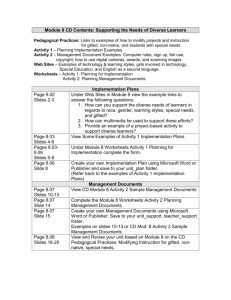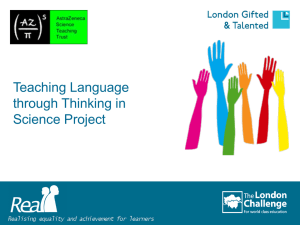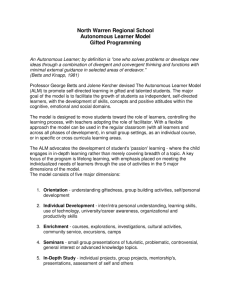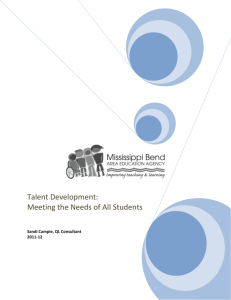Choice and Contracts PP
advertisement
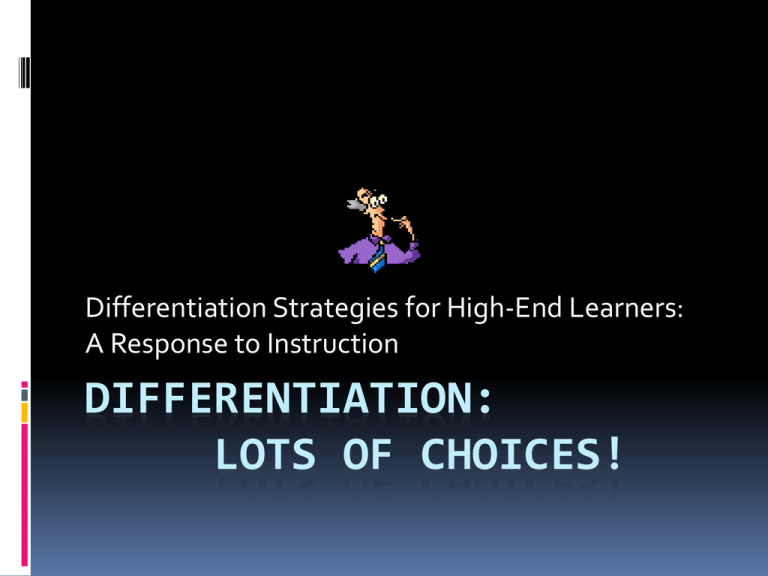
Differentiation Strategies for High-End Learners: A Response to Instruction DIFFERENTIATION: LOTS OF CHOICES! Fascinating Facts: Gifted learners require only 1-3 repetitions to learn a new skill in their strength areas. Average learners require up to 15 repetitions. When gifted learners must participate in too many repetitions or the learning pace is too slow, they may actually “mislearn” material (Julian Stanley, John Hopkins University). Gifted learners have special learning needs in their area(s) of giftedness: Depth Complexity Accelerated Pacing Opportunities for creative production and creative expression As well as unique : Affective Needs Deserve to learn something new EVERYDAY! Non-Negotiables Different respectful work, not simply more work. Builds Deeper Understanding. Provide rigorous, challenging activities. Try to weave two or more elements and/or combine Both types of thinking tools to increase intellectual demand . Fair in terms of work expectations and time needed. Choice When given the freedom of choice and adequate information, the brain’s prefrontal cortex (decision-making, planning, critical thinking) and amygdala (fear response) have been found to respond positively (Bechara, et al. 1999). This effect is likely triggered by the increased production of serotonin, dopamine, and noradrenaline, which enhance well-being and motivation. So, it turns out that choice may, indeed, “feed the brain.” Jensen, Eric, & Dabney, Michael, Learning Smarter, 2000 Choice Choice activities give students options. Even if the options all include doing work, there is something liberating about being able to choose the activity for which you will later be assessed. Students’ interests and learning styles are taken into heavy consideration when preparing choice activities. Even the content to be learned may be part of the choices students get to make. They could be learning facts, concepts or a variety of useful and practical knowledge. Choice As with related strategies, it is important that no matter which choices students make, they must grapple with the key ideas and use the keys skills central to the topic or area of study. In other words, whichever choices the student makes, he/she should be addressing the same KUDs as the others Choice A choice board offers students a way to make decisions about what they will do in order to meet class requirements. A choice board could be for a single lesson, a week-long lesson, or even a month-long period of study. In order to create a choice board: Identify the most important elements of a lesson or unit. Create a required assignment or project that reflects the minimum understanding you expect all students to achieve. Create negotiables which expand upon the minimum understandings. These negotiables often require students to go beyond the basic levels of Bloom's Taxonomy. Create a final optional section that provide students the opportunity for enrichment. The optional section often reflects activities that students can use for extra credit. from Fair Isn't Always Equal: Assessing and Grading in the Differentiated Classroom by Rick Wormeli Menu Planner Name: _________________ Due: All items in the main dish and the specified number of side dishes must be completed by the due date - ________. You may select among the side dishes, and you may decide to do some of the dessert items, as well. Main Dish (Complete all) 1. 2. 3. Side Dish (select _________ ) 1. 2. 3. Dessert (Optional) 1. 2. 3. . Tic Tac Toe Draw a pictorial representation of an important historical event. Your picture should include all of the important elements such as setting, date, and characters to help you remember the event. Draw a mural of an important historical event. Make sure to include the main concept, the events leading up to it, and the events that followed, or that you predict will happen in the future because of the event. Make a pictorial timeline of a historical period or event, as well as the events leading up to it. Make a parallel pictorial timeline of other historical events in other regions that were happening simultaneously. Use a graphic organizer to note any related patterns or universal causes. Use or make up a flow chart or graphic organizer to illustrate the sequence of events of a historical happening. Create a secret code and write a message to someone involved in an important historical event. The message must indicate a core understanding of the event and its circumstances. Draw a political cartoon representing a historical event. Make up a comic strip relating an important historical event. Make up a set of skits or a play about a historical event. Make sure to show the event from different perspectives and include the different points of views of the characters involved. Assume the persona of a historical figure and give a presentation or speech to an audience relating why you acted as you did to solve a significant historical problem. Then share with the audience how you might solve the problem in an alternative way. Dress in character. Choice RAFT is an acronym for Role, Audience, Format, and Topic. In a RAFT, students take on a particular role, develop a product for a specified audience in a particular format and on a topic that gets right at the heart of what matters most in a particular segment of study. At some points, a teacher may want to assign students particular RAFTs and at other points may want the student to make the choice. RAFT assignments are typically of fairly short duration and can be completed at school or at home. From Fulfilling the Promise of the Differentiated Classroom by Carol-Ann Tomlinson RAFT R Role A Audience F Format Spilled Oil People of Gulf Coast Rap BP Marine Life Persuasive letter Fish Seabirds (Pelicans, Terns, Gannets, etc.) Poem T Topic It’s Not My Fault! Relocation To A New Home- There’s A Better Meal Around The Corner! Contracts-Advantages Allow students an element of choice in assignment or unit grade. Challenge and engage mastery students while teachers work with struggling learners. Make students responsible for their learning. Contracts: Disadvantages Require a level of maturity and self discipline for students. Time management can be challenging. Take time to plan. Non-Negotiables of Contracts Meet with student at regular intervals to monitor progress. Set deadlines (can be flexible). Allow flexibility of student movement to accomplish varied tasks. Accompany contract with student rubric for self-evaluation and self-reflection. Different Types of Contracts •Open-ended, Interest driven •Short or long-term •Skills or Content •Student choice of activities within a discipline with varied possible points depending on complexity of task (Core content only) •Contracts for grades in exchange for completing specific activities (Core content only). Contracts: Suggestions for Behavior Management •Expected behaviors embedded in contract with specific consequences •Establish rules for checking in and out of classroom if resources are at another location •Students set clear goal/s before leaving classroom •Progress journals to report on progress upon return. Contracts: Let’s look at some examples of student contracts. SAMPLE CONTRACT (OLDER PRIMARY CHILD) Name_______Kristin Blakely___________________________________ This is what I want to learn (FACTS AND CONCEPTS): 1. How to make a good plot for a story 2. The elements of plot: (a) good hook in the beginning, (b) suspense in the middle, (c) a climax, and (d) a strong ending. This is what I need to do (SKILLS): 1. Read two stories with good plots I like. 2. Brainstorm some plot ideas of my own. 3. Put my idea into each section of the plot to see how it works. This is what I will create (PRODUCT): A mystery story of my own with sketches These are the things I have to do before I am finished: Use at least two books to get the information I need Remember the important things by writing them down and making diagrams, designs, and maps. Figure out at least three ways to do my project. Choose one way and do the project. Ask the teacher for help if I get stuck. I will complete my project by: Friday Student Signature:_____________________________________ Teacher Signature:_____________________________________ Tic-Tac-Toe Menu/Contract 1. 2. 3. 4. 5. 6. 7. 8. 9. Name: _________________________________________ Date Received:_____________ Date Due:_____________ Date Completed:_________________ Directions: Choose activities in a tic-tac-toe design. When you have completed the activities in a row–horizontally, vertically, or diagonally–you may decide to be finished. Or you may decide to keep going and complete more activities. I choose activities # _________, # ________, # ________, # ________ Do you have ideas for alternate activities you’d like to do instead? Talk them over with your teacher. I prefer to do the following alternate activities: _______________________ _____________________________________________________________ Bibliography: Gregory, G. H., & Chapman, C. (2002). Differentiated instructional strategies: One size doesn’t fit all. Thousand Oaks, CA: Corwin Press. Diehn, G. (1998). Making Books that Fly, Fold, Wrap, Hide, Pop Up, Twist & Turn. Lark Books, NY. Kingore, B. (2004). Differentiation: Simplified, Realistic, and Effective. Professional Associates Publishing. Heacox, D. (2002). Differentiating instruction in the regular classroom. Free Spirit Publishing, Minneapolis, MN. Keen, E. & Zimmermann, S. (1997). Mosaic of Thought. Heinemann, Portsmouth, NH. Bibliography Continued : Smutney, J., Walker, S., & Meckstroth, E. (1997). Teaching young gifted children in the regular classroom. Minneapolis, MN: Free Spirit. Tomlinson, C. A. (1999). The differentiated classroom: Responding to the needs of all learners. Alexandria, VA: Association for Supervision and Curriculum Development. Treffinger, D. & Nassab, C. (1997). Thinking Tools Lessons. Center for Creative Learning Press. Winebrenner, S. (2001). Teaching Gifted Kids in the Regular Classroom. Free Spirit Publishing Bibliography Continued: Kingore, B. (2004). Differentiation: Simplified, Realistic, and Effective, Professional Associates Publishing. Naglieri, J., Brills, D. & Lansdowne, K. (2008). Helping All Gifted Children Learn. Pearson Publishing.

